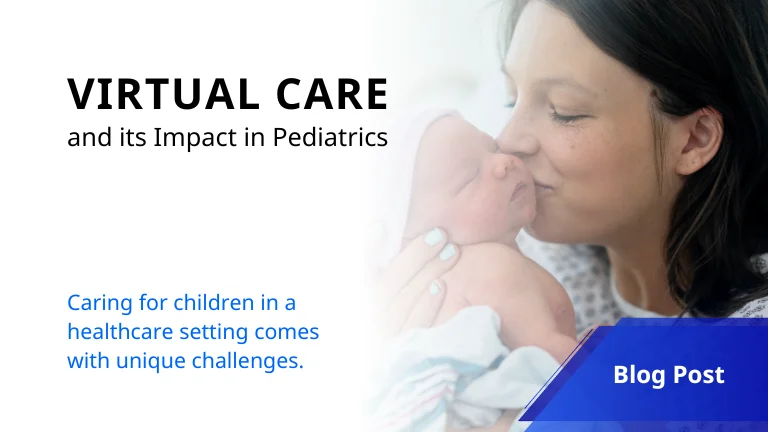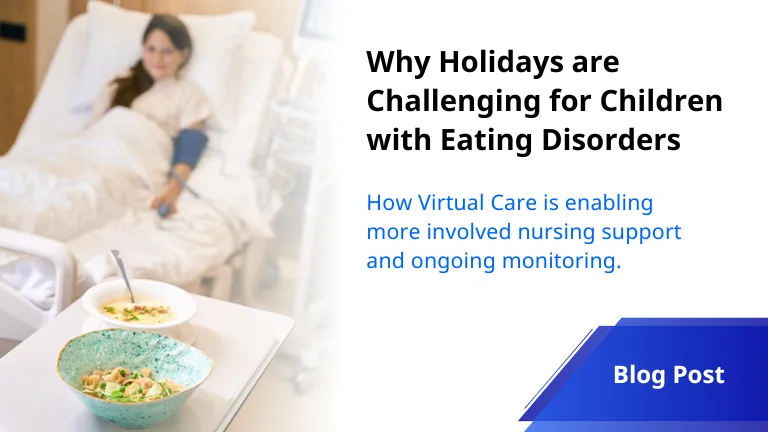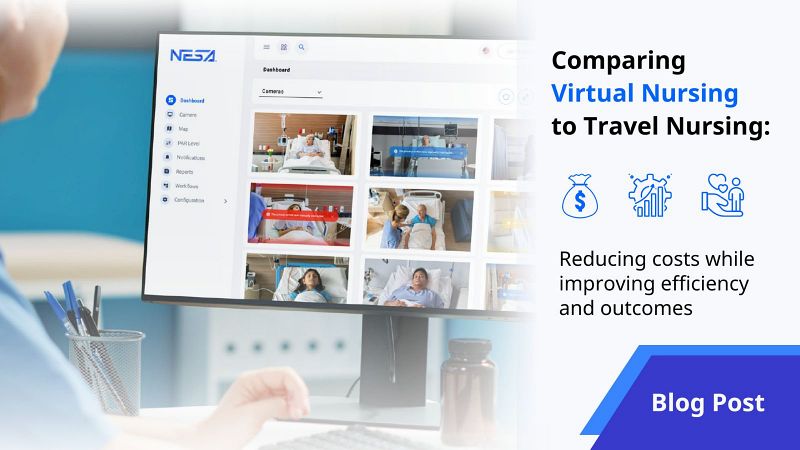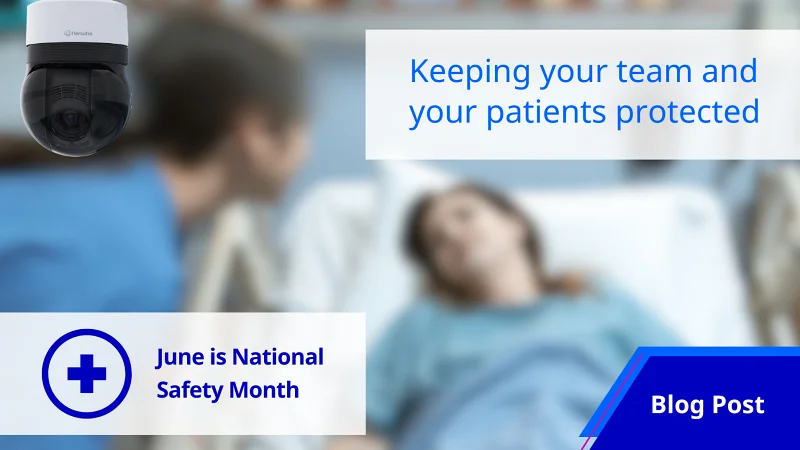
Virtual Care isn’t just about technology, it’s about fostering connections, comfort, and confidence in the care we provide. Caring for children in a healthcare setting comes with unique challenges. Children have developmental and emotional needs that differ from adults, requiring specialized approaches from nurses and providers. From managing risks like tampering with medical equipment, attempting to leave the hospital, and preventing falls, as well as addressing destructive behaviors and eating disorders, pediatric patients need care tailored just for them.
Nurses need targeted support to effectively address these unique challenges. Virtual Careprovides an essential solution by ensuring continuous monitoring, reducing interference with medical devices, and supporting in the management of behaviors and eating disorders in pediatric patients.
Additional advantages include improved access to care, greater convenience, and flexibility for families. It ensures continuity of care by providing consistent support, while enhancing the patient’s experience. Virtual Nursing also fosters enhanced patient engagement and education, empowering children and their families to actively participate in managing health conditions. Additionally, it is cost-effective, helps integrate multidisciplinary teams for comprehensive care, and opens the door for innovative therapeutic interventions.
In a Labor and Delivery (L&D) unit, Virtual Nursing can play a vital role in supporting the care of mothers undergoing detoxification, where the risk of newborns being dropped may be heightened due to withdrawal symptoms, fatigue, or impaired judgment. Virtual Nurses can assist by providing continuous monitoring, education, and support that reduces the likelihood of such incidents.
Here are some of the detailed use cases where Virtual Care can be utilized:
One of the critical aspects of managing eating disorders is ensuring proper food intake and preventing harmful behaviors like food hiding or purging. Virtual Care can provide real-time observation during meals to support children and adolescents in consuming appropriate portions and discouraging food-related anxiety or avoidance.
Example: A remote care provider can monitor the child during mealtimes through video, offering guidance and emotional support, helping manage anxiety, and preventing behaviors like hiding food or excessive chewing.
Behavioral Monitoring and Crisis Prevention
Children with eating disorders may experience heightened anxiety, stress, or emotional distress, especially around mealtimes or body image concerns. Virtual Care allows remote behavioral monitoring, ensuring early detection of emotional crises or harmful behaviors like self-harm, binge eating, or purging.
Example: A Virtual Care provider can monitor signs of emotional distress, provide immediate counseling, and intervene to prevent harmful actions like purging or over-exercising after meals.
Virtual Care can facilitate group therapy sessions where children and adolescents with eating disorders can share their experiences and receive peer support during their hospitalization. This inpatient community aspect is crucial for reducing feelings of isolation and fostering a sense of belonging.
Example: A virtual group therapy session can be organized where patients discuss coping strategies, share their progress, and support one another under the supervision of a healthcare professional.
Continuous Virtual Monitoring of Mother and Baby
Virtual Nurses can monitor the mother and baby in real-time to ensure safety. If the Virtual Nurse notices signs of drowsiness, confusion, or unsafe handling of the baby, they can immediately alert the bedside team or assist the mother by guiding her through safe handling.They can also provide reminders to mothers about safe positioning, especially when feeding, burping, or cuddling the baby. This can help reinforce the importance of holding the baby securely, particularly during times when the mother might be at higher risk of being drowsy or disoriented.
Example: Virtual Nurses can assess signs of withdrawal symptoms, such as tremors, fatigue, or confusion, that may increase the risk of the mother accidentally dropping her baby. Early detection of these symptoms allows for timely intervention.
Consistent Messaging
Virtual Nurses can ensure that families receive consistent, evidence-based education about their child's condition, treatment plan, medications, and post-discharge care. This helps prevent misinformation or conflicting advice.
Example: Families may need to hear information multiple times to fully absorb it. Virtual sessions allow for repetition and reinforcement of key points without burdening the bedside team.
Virtual Nurses can customize educational content to be age-appropriate, using child-friendly language and materials to ensure young patients also understand aspects of their care.
Example: For pediatric patients with chronic illnesses (e.g., asthma, diabetes), virtual nurses can provide ongoing education, offering long-term support to families managing these conditions.
Cultural and Language Accessibility
Virtual Nurses can facilitate multilingual sessions or access to interpreters, ensuring that non-English-speaking families receive accurate and understandable education.
Example: Virtual Nurses can offer culturally tailored education, addressing family beliefs, values, and preferences, which improves trust and engagement in the care process.
Postpartum and Lactation Support
Virtual Nursing enhances postpartum and lactation support by providing immediate, expert guidance at the bedside. This approach ensures timely interventions, reduces delays in care, and allows for tailored education that empowers new mothers during their hospital stay.
Example: A postpartum patient experiencing challenges with breastfeeding connects with a virtual lactation consultant who provides step-by-step guidance on proper latching techniques and answers questions in real time, ensuring the mother feels supported and confident before discharge.
Virtual Nursing enhances newborn observation by providing continuous, real-time monitoring to detect subtle changes in vital signs and behavior. This allows for early identification of critical conditions, such as respiratory decompensation, enabling timely intervention and improving outcomes.
Example: A Virtual Nurse monitoring a newborn notices a decline in oxygen saturation and increased respiratory effort. They immediately alert the bedside team, ensuring rapid response and stabilization of the infant’s condition.
Virtual Nursing strengthens NICU care by offering constant oversight and expert support, ensuring that even subtle changes in a newborn’s condition are quickly identified. This proactive approach enhances safety and enables timely interventions, improving outcomes for fragile infants.
Example: A Virtual Nurse monitoring NICU patients detects early signs of respiratory decompensation, such as subtle shifts in oxygen saturation and breathing patterns. They promptly notify the bedside team, facilitating immediate intervention to stabilize the newborn and prevent further complications.
Family Involvement
Virtual Nursing enhances family involvement by providing consistent communication, education, and support, ensuring families stay informed and actively participate in their child’s care plan. This approach builds trust and empowers families to collaborate with the care team.
Example: A Virtual Nurse connects with parents via two-way video to explain their child’s treatment plan, answer questions, and provide guidance on managing medications and nutrition. This ongoing engagement ensures the family feels supported and confident, even if they cannot be at the bedside 24/7.
Conclusion
In summary, Virtual Care is transforming pediatric healthcare by offering innovative solutions that enhance patient safety, support clinical teams, and foster family involvement. From continuous monitoring and early detection of critical conditions to providing expert consultation in areas like lactation and respiratory care, Virtual Care ensures that pediatric patients receive the best possible care, no matter the circumstances. With the ability to connect families, empower them with knowledge, and provide timely interventions, virtual nursing is paving the way for a future where every child can thrive in a more connected, compassionate, and efficient healthcare environment.



